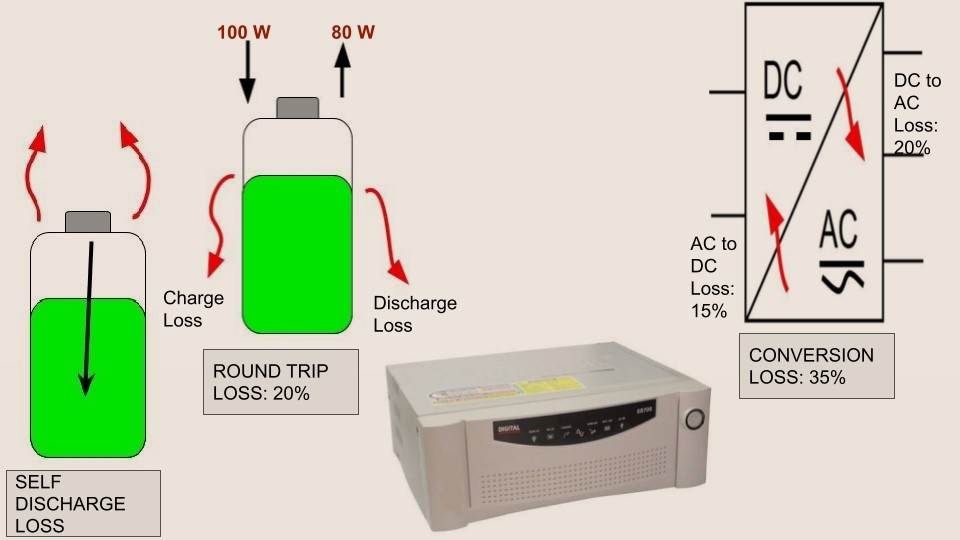
Did you know the fact that there is around 45%-60% energy loss in Home inverters?
Most people believe that the loss associated with using the battery power in the home inverters are negligible. But, this is not true.
Have you ever checked the electricity bill with and without the home inverter??
If you will check you will find a sizable difference in the bill value. The difference will depend on the hours of inverter used. Do you know why??
Because around 55%-60% of the extra energy is required to compensate for the losses associated with battery use. This means that for 1 kWh (Kilowatt Hour) of energy produced by the inverter you pay 1.6 times the grid tariff.
Consider for example the grid tariff in your area is Rs. 6.5/Unit, then you will pay approx Rs. 6.5 *1.6 = Rs.10.4/Unit.
Why is there so much loss of Electrical energy??
The reason for the loss is that there are various kinds of loss associated with inverter use. Below, we have summarized various kinds of losses on using the home inverter:
a. AC to DC Conversion Loss:
The home inverter converts grid-supplied AC to DC for charging the battery bank. Around 15% of energy is lost in converting the AC from the grid supply to DC.
(Source: https://ieeexplore.ieee.org/stamp/stamp.jsp?arnumber=8378378 )
The solar power is already DC power, so this conversion loss is not associated.
b. Round Trip Loss:
It is the internal loss within the battery in the conversion of DC to chemical energy and chemical energy back to DC. (DC-to- storage- to- DC). On charging the battery, the ionic flow within the battery bank is reversed and reverse polarity takes place. This creates internal resistance within the battery bank and heat is dissipated. In lead-acid, Gassing is another loss caused. Gassing is a breakdown of H2O to H2 and O2 within the electrolyte. Around 20% of the energy is wasted due to the above reason (Source of information: https://batterytestcentre.com.au/project/lead-acid/ ). This loss is associated with both systems.
c. DC to AC Conversion Loss:
To get the power from the battery bank, the DC produced has to be reconverted to AC. Around 20% of the energy is again lost in reconverting the stored DC into AC. This loss is associated with both systems.
d. Charge/Discharge Loss:
Lead-acid batteries lose the ability to accept a charge when discharged for too long due to sulfation, the crystallization of lead sulfate. This leads to a loss of 5% to 50%. (source: https://en.wikipedia.org/wiki/Lead%E2%80%93acid_battery).
e. Other Losses:
Apart from this few more losses are associated with inverter use as follows:
- There is some leakage of stored charge within the battery.
- Even when the battery is fully charged some energy is consumed by the inverter.
- The resistance of the wire from the battery to the inverter and inverter to the mains supply also cause some loss of energy.
- Usually, these losses are small.
Adding the losses on using the home inverter, we can assume that the power loss is around 60% in getting the power from the home inverter.
In the case of solar power, since solar power is free, the loss doesn’t affect the cost of power used from it. But in the case of the home inverter, since the grid power is used the cost of using the inverter power increases to 1.6 times the grid power tariff.

